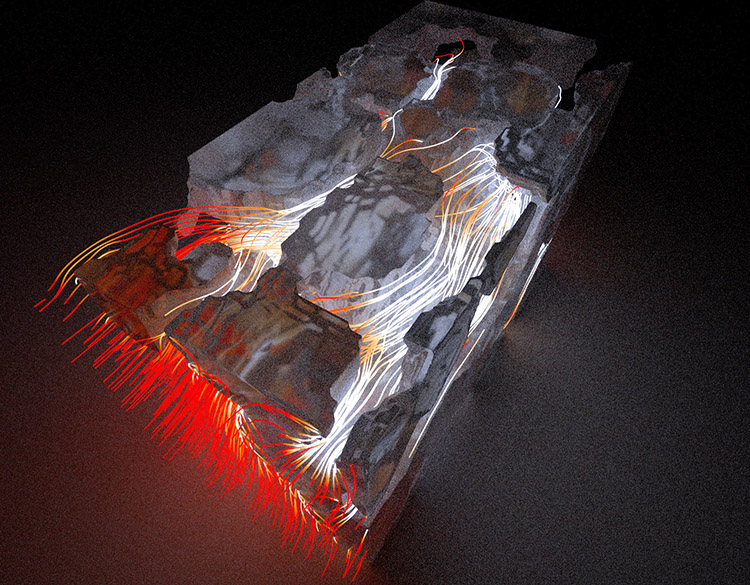CAEBAT Model Featured on American Chemical Society Journal Tenth Anniversary Issue Cover

Electrochemical simulation within a 3D nickel manganese cobalt electrode microstructure during a 20-minute fast charge. Streamlines represent Li-ion current in the electrolyte phase as ions travel through pores between the solid active material particles. Colors represent current magnitude. Illustration by Francois Usseglio-Viretta and Nicholas Brunhart-Lupo, NREL.
NREL's collaboration with Purdue University's School of Mechanical Engineering has yielded new insights for lithium-ion (Li-ion) battery electrodes at the microstructural level, which can lead to improvements in electric vehicle (EV) battery performance and lifespan. A stochastic algorithm developed by Purdue University, as part of NREL's Advanced Computer-Aided Battery Engineering Consortium, is prominently displayed on the cover of the 10th anniversary issue of American Chemical Society's Applied Materials and Interfaces. The NREL/Purdue team's corresponding article, "Secondary-Phase Stochastics in Lithium-Ion Battery Electrodes" detailing the research and resulting discoveries, is showcased inside.
This work builds on earlier phases of the U.S. Department of Energy's Computer-Aided Engineering for Electric-Drive Vehicle Batteries (CAEBAT) program. NREL's energy storage team has led key research projects since CAEBAT's inception in 2010, resulting in the creation of software tools for cell and battery design, as well as advancements in crash simulations used by many automakers.
This next phase of CAEBAT focuses on Li-ion electrode microstructure applications (accurately simulating the physics and geometric complexity of a battery) to better understand the impact materials and manufacturing controls have on cell performance. Li-ion batteries represent a complex non-linear system and considering EVs use larger batteries with more complex configurations, it is imperative to understand the interplay between electrochemical, thermal, and mechanical physics.
Says Kandler Smith, NREL co-author on the article, "Batteries are an exceedingly complex system—both in terms of their physics and geometry. In a real battery, it's difficult to get a clear view of what's going on inside, because so few measurements are possible. Models are a place where all physics can come together and the advantage of the model is that everything can be measured and probed. As we build an increasingly accurate physical understanding of batteries, we can expect that technological advances will follow."
The secondary phase in Li-ion electrodes, comprised of inert binder and electrical conductive additives, has been found to critically influence various forms of microstructural resistances. This phase has benefits for improved electronic conductivity and mechanical integrity but may block access to electrochemical active sites and introduce additional transport resistances in the pore (electrolyte) phase, thus, canceling out its original advantages.
Because the secondary phase is important for electrode mechanical integrity and electronic conductivity, its recipe and morphology will have a strong impact on battery kinetics and transport. The algorithm created and explained in the journal article explores morphologies for this phase. Stochastics comes into play as each microstructure variant is numerically generated multiple times using random seeds to ensure statistically relevant conclusions. By simulating battery electrochemistry on the various microstructure geometries, researchers can calculate the pore size of an electrode's microstructure geometry as well as the lithium displacement within an electrode to evaluate the difficulty of movement. Finding ways to overcome resistances via electrode microstructural modifications can greatly improve overall Li-ion battery performance.
The value of this work is that improvements to Li-ion batteries—the most expensive and complex component in EVs—is helping to overcome the concerns consumers have that limit EV adoption, including restricted driving range and high costs.
Learn more about NREL's energy storage research.
Last Updated May 28, 2025
